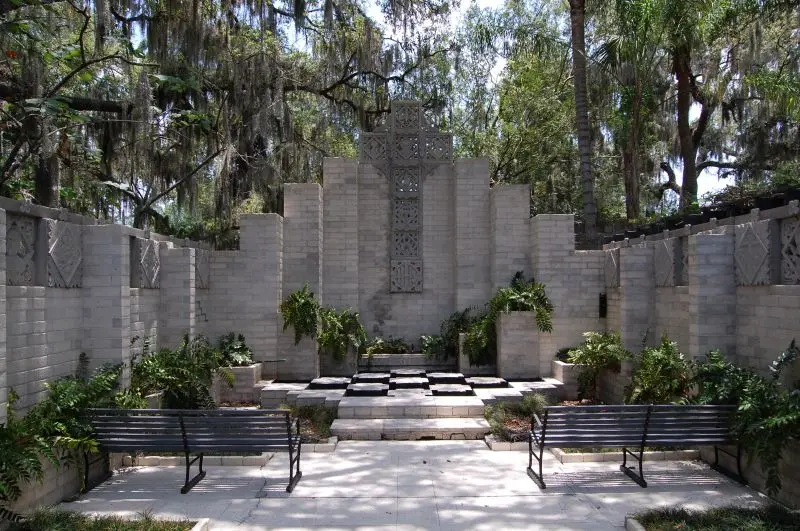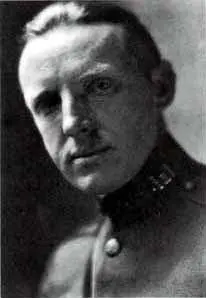Florida Today 16
Florida Frontiers “Jules André Smith and the Maitland Art Center”
Ben Brotemarkle
Artist, architect, writer, and World War I veteran Jules André Smith intended to move from Stony Creek, Connecticut to Miami, Florida, to enjoy a peaceful retirement. As he traveled through Central Florida in 1932, Smith saw a beautiful sunset on Lake Sybelia in Maitland and decided he needed to go no further.
By 1937, Smith had designed and built an artist’s colony called the Maitland Research Studio, which included one of only three art galleries in the state of Florida. An example of Fantasy Architecture, the design of the compound included a unique juxtaposition of Mayan and Christian imagery.
Today, Smith’s whimsical buildings are known as the Maitland Art Center.
In 1880, Jules André Smith was born in Hong Kong to American parents. His father was the captain of a naval ship. When Smith was four years old, his father died at sea, and he and his mother moved to Germany. A few years later the family relocated to New York and eventually settled in Connecticut.
Smith’s first love was art. His mother did not consider this a serious way for her son to make a living, so he earned both a bachelor’s degree and a master’s degree in architecture from Cornell University. Smith never stopped creating drawings, engravings, and etchings. His art ranges in style from the realistic to the abstract, which might explain the functional yet fanciful architectural elements incorporated into the Maitland Art Center.
After college, Smith received a fellowship to study art in Europe. He was the first of eight artists selected by the U.S. government to go to France in 1918, to record military activities through his drawings and sketches. After World War I, Smith published one hundred of his drawings in a book called “In France with the American Expeditionary Forces.”
Smith designed the Distinguished Service Cross that is still awarded today.
In 1924, Smith lost a leg as the result of an ignored injury he received during officer training seven years earlier.
While living in Connecticut after the war, Smith designed theater sets for the Parish Players. His experience as a set designer led Smith to write and illustrate a book called “The Scenewright” in 1926. By the early 1930s, Smith had grown tired of the cold northern winters.
In Maitland, Smith became friends with Broadway actress Annie Russell, a professor of theater arts at nearby Rollins College. Smith designed sets and costumes for theatrical productions at the college. Russell introduced Smith to Mary Curtis Bok, who would later become Mrs. Efram Zimbalist, Sr.
Smith and Bok shared a passion for the controversial “modern art” that was developing in the early twentieth century. Bok offered to build Smith a laboratory studio where he could experiment with art. Smith envisioned an artists’ compound where he could invite prominent American artists to live and work.
The compound Smith designed consists of art studios, living quarters, and a gallery. For twenty-two years the compound was the winter residence of well-known artists such as Ralston Crawford, David Burlick, Ernest Roth, Milton Avery, Arnold Blanch, Doris Lee, and Harold McIntosh.
Across the street from his compound, Smith built an unusual courtyard, garden, and roofless chapel.
A curious blend of Mayan and Christian imagery can be found throughout the complex maze of courtyards and hidden gardens connecting the twenty-two buildings of Smith’s artists’ colony. A stone carving of an Mayan warrior can be found on the opposite wall from a relief sculpture of the Holy Family.
An eclectic group of artists lived and worked at the compound every year from 1937 until Smith’s death in 1959. The buildings were dormant for ten years after that and in danger of being demolished. In 1969 the property was purchased by the city of Maitland, and in 1971 the compound was reopened as the Maitland Art Center.
In 1982, the Maitland Art Center was placed on both the State and National Register of Historic Places.
Today the Maitland Art Center keeps Smith’s dream of promoting contemporary American art alive by offering art classes and workshops, providing work space for resident artists, and presenting exhibitions in the gallery.
The sunsets on Lake Sybelia are still beautiful.
Dr. Ben Brotemarkle is executive director of the Florida Historical Society and host of the radio program “Florida Frontiers.” The show can be also heard online at myfloridahistory.org.

